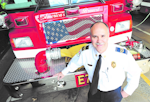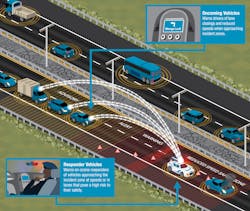Fire Service Technology: The Future of Connected Vehicle Technology
Every emergency incident has inherent and well-documented dangers associated with emergency vehicle response and while operating in roadways at incidents, especially vehicle accidents. Fortunately, connected vehicle technology will provide exciting new vehicle operating features that will enhance firefighter safety while responding to and operating at emergency incidents.
Alarming statistics
A variety of statistics and reports underscore the need for improved vehicle technology and communication. According to the National Highway Traffic Safety Administration (NHTSA), there were 5.6 million crashes in 2013 with 32,719 deaths. The Texas Transportation Institute reported that highway users spent 6.9 billion hours struck in traffic in 2014, with vehicles consuming 3.1 billion gallons of fuel. This disruption in travel also disrupts other emergency response routes and general commerce.
Secondary crashes and responders being struck by vehicles are very significant dangers as well. Traffic Incident Management advocate Jack Sullivan shares that the Emergency Responder Safety Institute (ESRI) has been tracking these incidents, and the number of fire and EMS line-of-duty deaths (LODDs) between 2008 to 2015 was 33. In addition to the LODDs, there are other disabling injuries that result from these incidents. ESRI tracked the number of struck-by-vehicle incidents—78 in 2011, 48 in 2012, 60 in 2013 and at least 34 incidents in 2014 where firefighters, EMS personnel and/or their vehicles were struck by other vehicles. For law enforcement, according to FBI reports, there were 154 police LODDs between 1998 and 2010 from struck-by incidents.
According to the Indiana Traffic Incident Management Effort Report, a report on secondary crashes, it was estimated that the chance of a secondary crash increases 2.8 percent for each additional minute it takes to clear the roadway. Statistical reports on secondary crashes vary depending on a number of factors. Various reports indicate that secondary accidents account for anywhere between 3 to 20 percent of all motor vehicle accidents. Additionally, the report concluded that for every minute that a freeway travel lane is blocked during the peak travel period, 4 minutes of delay is generated. Thus a 60-minute incident in rush hour will take 240 minutes to return to normal flow.
Enhancing roadway safety
The convergence of vehicle technology, connectivity and applications is having an impact on the world of vehicle technology. Presently, the U.S. Department of Transportation Intelligent Transportation Systems Joint Program Office (ITSJPO) is working on developing a “Connected Vehicle” strategy. This initiative involves the Federal Highway Administration, the Federal Motor Carrier Safety Administration, the Federal Railroad Administration, Federal Transit Administration, the National Highway Safety Administration and the Office of the Assistant Secretary for Research and Technology. This strategy includes several components: Intersection Movement Assist, Connection Protection, Dynamic Ridesharing, Road Weather Applications, Connected Vehicles for Emergency Services, and Environmental Applications. Each of these individual major areas has a potential impact for emergency responders and citizens, as they can potentially prevent primary vehicle crashes and/or reduce impact and dangers from secondary crashes or struck-by incidents.
In terms of the Connected Vehicles for Emergency Services element of the Connected Vehicle strategy, the next generation of applications that will transform this process are broken into the following categories: Response, Emergency Staging and Communications, Uniform Management, and Evacuation (RESCUME).
The on-scene functional aspect of Connected Vehicle technology focuses on two specific areas. First, signals from emergency response vehicles inform oncoming vehicles of a crash ahead, and signals from other vehicles indicate their slowing speed. This allows oncoming drivers to make smart decisions by taking an alternative route or by slowing. This is particularly important if there are visibility issues like fog, snow or heavy rain. Second, signals from oncoming traffic will warn emergency personnel of vehicles that are approaching at an unsafe speed. This is intended to give responders time to move to a safe position. Ultimately, these features, combined with autonomous vehicle safety features, may prevent the accident all together.
This communication is achieved through Dedicated Short-Range Communications (DSRC), a technology similar to WiFi. DSRC is fast, secure and reliable, and allows cars, trucks, buses and emergency vehicles to “talk” to each other. Vehicles are constantly sharing safety and mobility information with each other. This technology will enable all vehicles to have a 360-degree field of awareness. This connectivity also allows “platooning,” which choreographs all vehicles moving in tandem at the same speed to maintain traffic flow and reduce the chances of crashes. Additionally, connected vehicles will communicate with other infrastructure like traffic signals, toll booths and other applications. Ideally the technology will work to prevent vehicle crashes and to slow vehicles in situations where the crashes cannot be prevented.
Public stakeholder input
Over the past several months, the Rylex PSC Team has been working with ITS America and the Transportation Safety Advancement Group to raise awareness of Connected Vehicle technology and its implications and benefits within the public safety community. Their collective effort has been to ensure that public safety has been involved on the front end of this developing technology and that its needs and requirements become drivers of the technology and associated standards/specifications. It will be important for members of public safety to stay involved by learning more and providing input toward the future and final rule-making.
In sum
This technological development regarding the future of intelligent transportation and connected vehicles is exciting on a number of fronts. Considering that there were 31,600 crashes involving fire department vehicles from 2000 to 2009 and 84,810 ambulance crashes from 1990 to 2011 (per a Connected Vehicles presentation in 2016), the promise of this technology is that it can dramatically reduce these statistics by preventing vehicle crashes, injuries and deaths of emergency responders and citizens alike.

Charles Werner
CHARLES WERNER, who is a Firehouse contributing editor, is a 45-year veteran of public safety. He served with the Charlottesville, VA, Fire Department for 37 years, serving the past 10 years as chief. Following retirement, Werner served for two years as senior adviser and acting deputy state coordinator for the Virginia Department of Emergency Management. He has chaired: DHS SAFECOM Executive Committee; IAFC Technology Council; National Information Sharing Consortium; and DHS/White House Incident Management Information Sharing SubCommittee. Werner currently serves as the director of DroneResponders Public Safety Alliance, chair of the National Council on Public Safety UAS and chair of the Virginia Secure Commonwealth UAS Sub Panel.






